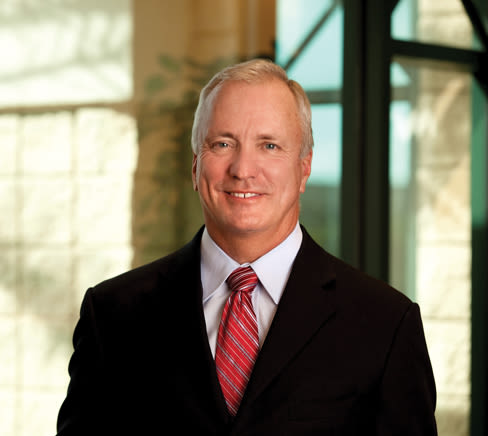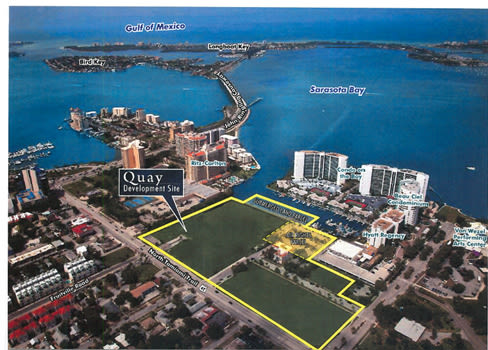Resurrection Man, Ed Burr

Jacksonville developer Ed Burr has a plan. No, a vision. He sees environmentally sustainable landscapes and pedestrian walkways connecting condominium buildings, offices, restaurants, shops, theaters and a bustling waterfront. It’s a development that people will want to visit and live in. It’s a place that’s totally unique—and decidedly Sarasota
“People don’t want to live in a tower; they want to live in a place. They don’t want to visit a building; they want to visit a place,” says the 59-year-old CEO of GreenPointe Holdings, which last year purchased the former Sarasota Quay property in downtown Sarasota for $27 million.
“It’s the greatest piece of land left on the Gulf Coast of Florida,” Burr says. “We’ve wanted to be in Sarasota for a long time, and this project will reflect the principles we think are important.”
Still unnamed at press time, GreenPointe’s project is a 14.5-acre tract along North Tamiami Trail that was the home of the former Sarasota Quay, a pink retail center developed in the 1980s. The property—large, flat, vacant and located on downtown waterfront near luxury residential and resort properties (The Ritz-Carlton, Sarasota is a next-door neighbor)—is a rare find in Florida. The previous owner, Irish American Management Services, headed by Patrick Kelly, in 2004 announced plans for a $1 billion development with up to 700 residential units, 189,000 commercial square feet and a hotel. But the real estate collapse stopped the project and led to foreclosure in 2013.
Burr, armed with lessons from the collapse and nearly 30 years of experience as a developer in Florida, says GreenPointe is the right company to resurrect the project, although he says it’s too early to talk about details and numbers.
GreenPointe now specializes in buying distressed properties and finishing uncompleted developments from the housing boom. Its portfolio includes 13 residential and mixed-use projects with 18,000 home sites throughout Florida. Examples include Triple Creek in Riverview, which was bought in 2010 and includes more than 2,000 home sites; Southern Hills Plantation in Brooksville, a 1,685-acre community with a championship golf course and homes priced up to $1.5 million; and River Hall in Fort Myers, a nearly 2,000-lot master-planned community with a championship golf course and more than 50 percent of the land dedicated to habitat conservation.

In discussing the Quay, Burr repeatedly uses the word “place,” and that’s no accident. “The term in the [development] business is called ‘place making.’ You don’t hear a lot of people use it, but talk to Ed for five minutes and you’ll hear it,” says Peter Rummell, a fellow Jacksonville-based developer, who has helmed some of Florida’s most prominent resort and residential projects with Arvida, the St. Joe Company and Disney.
“Ed is not afraid of risk and new, complicated projects,” Rummell adds. “I haven’t seen plans for Sarasota, but Ed’s talked to me about it. It fits the description of hard-to-do but big payoff.” Rummell is referring to the project’s complicated multi-use features that will take years to accomplish.
Burr, who grew up in a modest home in a small community near the beaches of east Jacksonville, went to the University of Tampa on a football scholarship (he played defensive end), though he quickly realized football would not be his meal ticket. He transferred to Florida State University, working as a waiter and bartender to pay the bills, and graduated with an accounting degree in 1979.
Burr got a job with Coopers & Lybrand (which eventually merged into PricewaterhouseCoopers) in Miami and New York City, where his developer clients piqued his interests in real estate. He moved back to Jacksonville in 1986 and formed the development company LandMar a year later. His first deal was Osprey Pointe, a master-planned community of 276 single-family homes along the St. Johns River.
LandMar developed nearly two dozen communities with 35,000 home sites and roughly $750 million in value over the next 12 years. Burr ended up selling his interest in the company to majority partner Crescent Resources in 2007. Crescent had a short shelf life, however. When the market collapsed, the company (including its LandMar affiliate) filed for bankruptcy. In the meantime, Burr had launched GreenPointe Holdings LLC, and was able to hire back his executive team from LandMar.
Burr says his experience with the housing collapse motivated him to focus on doing things “the right way”—a slower, more market-driven approach using sustainable features, rather than the build, build, build frenzy of the boom.
“With urban infill projects and downtown projects, you have to be able to lean into the market when it’s ready and be patient when it’s not,” Burr says. “With a project the size of the Quay, you can’t just do everything at once. We have a long view of the Quay. You can’t outpace and outrun the market.”
Burr says utility infrastructure and the first phase, likely residential, will begin within the next 12 to 24 months. He doesn’t have details yet, though he expects the historic Belle Haven building on-site will be preserved in some way.
“With the Quay, we are making sure there is pedestrian connectivity to the rest of the city, the arts district, the urban downtown and to the Rosemary District.”
GreenPointe focuses on avoiding “cookie-cutter” developments, Burr says. Each project has a “green point” that could be anything from water conservation to energy efficiency to preserving habitat. The Quay’s green points likely will feature green building design and water and electricity conservation.
Burr also supports Bayfront 20:20, an initiative of civic and business leaders who are trying to make sure the 75 acres of vacant or underused downtown waterfront neighboring the Quay and additional parcels across North Tamiami Trail incorporate cultural assets and public access.
“With the Quay, we are making sure there is pedestrian connectivity to the rest of the city, the arts district, the urban downtown and to the Rosemary District,” he says. “We also want [the Quay project] to be a place for pedestrians to gather. The amenities will give it a sense of place, not only for people who live at the Quay, but for everyone.”
Burr is not revealing details, and GreenPointe executives expect him to keep tweaking the project until the concrete is dry. “You’ll think a decision has been made, but a couple of meetings later Ed’s opinion may have changed and now there’s a different direction,” says Rick Harcrow, regional president for GreenPointe Communities, the development arm of the company. “That’s part of Ed’s personality. He never stops trying to improve on the last decision.”
Burr likes to focus on the big picture while letting his team handle the details. “He can drill down in great detail on subjects, but his management style is to keep people focused on the target,” says GreenPointe Communities president Grady Miars, who has worked with Burr since 1996 at LandMar. “He’s careful not to lay out the steps of what you should do next. He sets the vision and direction and gives a lot of flexibility on how you get there.”
Burr says that approach can work if you surround yourself with quality employees. “I can think of maybe three times in my career when I’ve had to tell somebody what to do,” he says. “We operate with an executive management team of strong-willed, smart people.”
Burr’s collaborative style extends to his involvement with various city and community boards in Jacksonville, as well as five years serving on FSU’s board of trustees. He led the search committee last year that selected John Thrasher as university president. Recently, Burr was named board chairman in a unanimous vote.
Burr says a priority for the board this year will be to help repair FSU’s image following several arrests of student athletes for sexual assault and other offenses. Although Burr says the university’s problem with student conduct has been overblown by media, he takes abuse involving young people seriously.
His charity, the Monique Burr Foundation for Children, offers child abuse prevention education programs to Florida elementary schools, as well as support programs for school personnel and parents about bullying, cyber safety and all forms of child abuse. The foundation is named after Burr’s first wife, a passionate child advocate who was killed in a car accident during the couple’s 10-year anniversary trip to California in 1996. She was 36.
“We’ve wanted to be in Sarasota for a long time.”
“I wanted her legacy to live on,” says Burr, who can sound reserved when discussing his business career, but exudes passion when describing the foundation. “We touched over a million children’s lives last year. Every time I hear of an abuse claim, I think, ‘Why didn’t that child have this type of education?’”
The foundation’s programs are approved for use in 57 of Florida’s 67 counties, though not in Sarasota. He hopes that might change, and that the Quay project won’t be the only impact he has on the local community.
“It will change not only children’s lives today, but it will change generations,” Burr says. “If you stop the cycle of abuse you are stopping generations of abuse. We’re not going to change the world, but we can change the lives of so many people.” ■
The CEO Says
Burr’s building blocks for success.
NEVER GIVE UP: “Being a CEO is tough. Things don’t always go well, and there isn’t always a clear path to a solution. Never discount the value of showing up and giving your best every day. If you work hard enough, the correct path becomes clearer.”
NOBODY WORKS FOR HIMSELF: “I often hear people say, ‘I want to own my own business so I can work for myself.’ There is no such thing. As an owner or CEO, you have immense responsibility to your employees, your customers, your lenders and partners and to the community.”
IT’S ALL ABOUT THE PEOPLE: “The old adage about ‘location, location, location’ matters, but it is not as important as the people you work with. We have one of the finest real estate development teams in the country. The right adage is, ‘People, People, Location.”
REPUTATION MATTERS: “What you do is important but how you conduct your business is the most important. Your reputation may be the only thing that lets you survive the tough times.”
GIVE BACK: “Whether time, treasure or knowledge. Give it!”